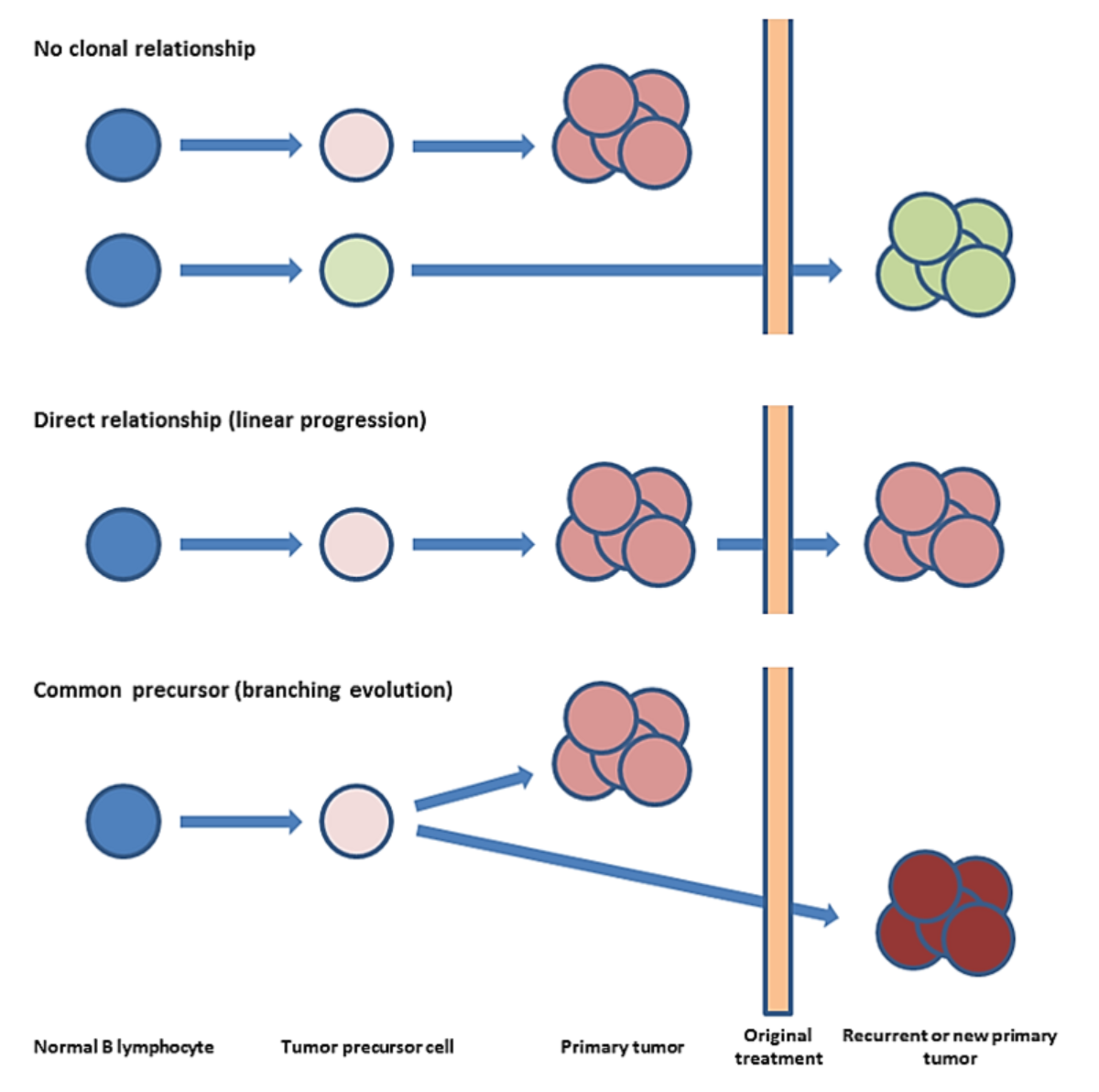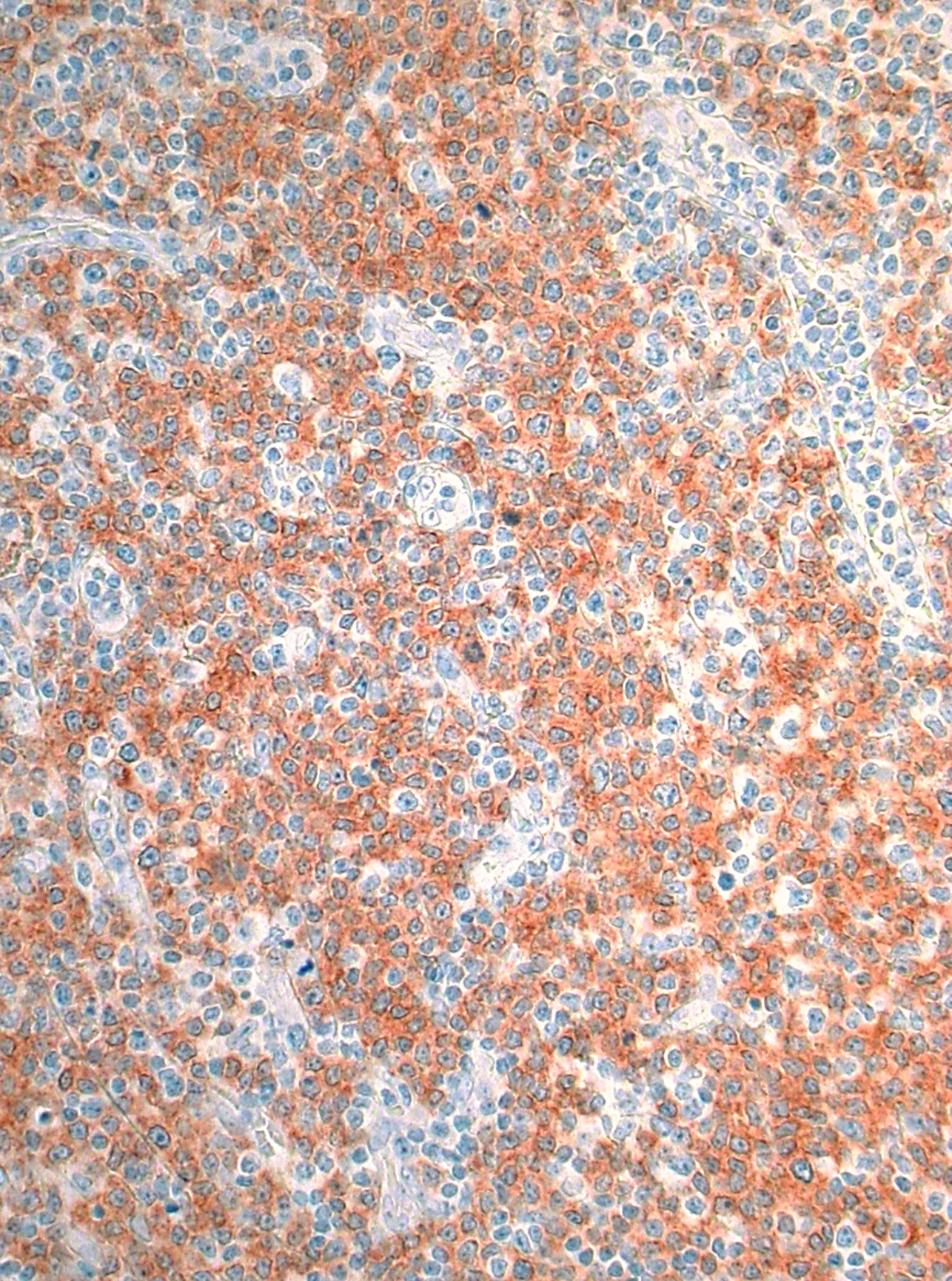Hematolymphoid Tumors
Principal Investigators




Prof. Alexandar Tzankov
Leitender Arzt und Fachbereichsleiter Histopathologie und Autopsie
Pathologie
Tel. +41 61 328 68 80
Our Science
Our hematopathology research group focuses on translational investigations and precision medicine of lymphomas. We have assembled a team of scientists to advance knowledge in the following distinct topics:
Clonal relationships and molecular evolution of relapsing lymphomas
A major research topic of our group is deciphering the clonal relationship and evolution of recurrent lymphomas. Relapses of lymphoid neoplasms, even after long-lasting clinical remission, were regarded until recently as direct outgrowths of the primary tumor. Only rarely clonally unrelated relapses have been documented as single case reports. We hypothesized that clonally unrelated (true "de novo") cases of "relapsing" lymphomas are more common than generally thought. By comparative immunoglobulin heavy chain-gene fragment length analysis of microdissected Reed-Sternberg cells from matched primary and relapsing classic Hodgkin lymphoma (HL) samples, we could demonstrate that a proportion of recurrences are clonally unrelated and, therefore, not true "relapses" of the original malignant clone (Clin Cancer Res. 2011;17:5268-5274). This may be of clinical significance because it raises the questions about the current aggressive clinical therapies in such instances (Figure 1).
We then extended the hypothesis of clonally unrelated relapses to diffuse large B-cell lymphomas (DLBCL). A cohort of paired relapsing DLBCL- and non-relapsing cases has been extensively studied (Leukemia 2016;30:2385-2395). We were able to demonstrate that true clonally unrelated DLBCL-recurrences do also occur. We could identify two distinct patterns of genetic evolution in clonally related relapses (early divergent/branching evolution versus late-divergent/linear progression) and potential early mutational drivers of lymphomagenesis (e.g., KMT2D, MYD88, CD79B), some of which are now used to predict sensitivity towards ibrutinib. In addition, we were able to detect mutations of distinct genes that were either linked to relapses(BCL2, MEF2B) or predicted lesser propensity for recurrences(SOCS1). Along this project, a next generation sequencing (NGS) panel for lymphomas has been developed in our lab that entered clinical routine after validation (Leuk Lymphoma 2018;59:1710-1716) and accreditation and is still the only one running in a diagnostic lab in Europe(https://www.unibas.ch/en/Research/Uni-Nova/Uni-Nova-128/Uni-Nova-128-New-treatment-concepts-for-recurrent-lymphoma.html). To address these issues at the single gene level in HL, we established a novel cell enrichment technique for robust genetic analysis of Reed-Sternberg cells (Lab Invest. 2018;98:1487-1499) and are currently running a respective project.

Figure 1: Concepts of lymphoma recurrences.
Upper row: 10 to 20% of clinical lymphoma relapses, i.e. same tumor entity occurring at two different time points, are clonally unrelated second tumors. The remaining are clonally related and show at least two different molecular evolution patterns. Middle row: In the linear evolution scenario, the tumor initially possesses a strong driver mutations. Therefore, the neoplastic cells grow fast and unrestricted, giving rise to a rather homogeneous primary tumor. Such a tumor is almost exterminated by the treatment but an acquired resistance emerges. The resistant subclone already has drivers of effective growth and replenishes the tumor mass giving rise to a more rapid relapse. Lower row: In the branching scenario, the divergence occurs early in tumor development. The majority of subpopulations stagnate but one clone eventually acquires the effective combination of driver mutations, expands and gives rise to a heterogeneous primary tumor. The dominant population is exterminated by the treatment, however, an intrinsically resistant subclone exists and gradually gives rise to a relapse
Deciphering the genetic landscape of marginal zone lymphomas
We decided to apply and extend this NGS panel towards more orphan lymphomas, namely marginal zone lymphomas (MZL). These are rare lymphoid tumors comprising three different, but morphologically and phenotypically closely related entities (splenic, nodal and extranodal MZL). Nodal MZL is a diagnosis of exclusion as defined by the current WHO-classification, has no disease-defining phenotype and its diagnostic borders to other B-cell lymphomas are blurred. By studying 25 nodal MZL, we identified for the first time recurrent and diagnostically useful BRAF-mutations, mainly V600E (Leukemia. 2018;32:2412-26; Figure 2). Most importantly, the V600E mutation of this gene is therapeutically relevant since a targeted treatment for this molecular alteration is approved in melanoma and relapsing hairy cell leukemia. We further extended our studies on MZL to ocular adnexal (OA) MZL. Preliminary data shows that TNFAIP3 mutations are highly specific and BCL10 mutations are probably prognostically important in OA MZL, and that OA lymphoid lesions bearing NF-κB compound mutations and/or mutations of acetyltransferase-encoding genes highly likely represent lymphomas (Der Pathologe 2019;40 Suppl. 2:S109-10). Finally, in MZL of the lung, we were able to detect higher frequency of cases without point mutations suggesting that these malignancies are more translocation-driven, and showed that - based on the dissimilar mutational profile between the two entities - DLBCL and MZL of the lung are unrelated (Modern Pathology. 2020; in press).

Figure 2: Nodal marginal zone lymphoma expressing V600E mutant BRAF
One significant discovery of ours is the detection of a recurrent mutation in BRAF gene in about 15% of marginal zone B cell lymphomas. This mutation is useful in that the mutated protein product can be visualized using simple staining methods as illustrated and is, therefore, diagnostically applicable, and the mutated protein product can be specifically targeted, at least in other types of cancer such as melanoma or hairy cell leukemia.
Selected Publications
- Stirm K, Leary P, Bertram K, et al. Tumor cell-derived IL-10 promotes cell-autonomous growth and immune escape in diffuse large B-cell lymphoma. oncoimmunology. 2021 Nov 22;10(1):2003533.
- Brune MM, Rau A, Overkamp M, et al. Molecular Progression of Myeloproliferative and Myelodysplastic/Myeloproliferative Neoplasms: A Study on Sequential Bone Marrow Biopsies. Cancers (Basel). 2021 Nov 9;13(22):5605.
- Bertram K, Leary PJ, Boudesco C, et al. Inhibitors of Bcl-2 and Bruton's tyrosine kinase synergize to abrogate diffuse large B-cell lymphoma growth in vitro and in orthotopic xenotransplantation models. leukemia. 2021 Nov 18.
- Bonfiglio F, Bruscaggin A, Guidetti F, et al. Genetic and Phenotypic Attributes of Splenic Marginal Zone Lymphoma. blood. 2021 Oct 15:blood.2021012386.
- Drexler B, Tzankov A, Martinez M, et al. Blast counts are lower in the aspirate as compared to trephine biopsy in acute myeloid leukemia and myelodysplastic syndrome expressing CD56. Int J Lab Hematol. 2021 Mar 11.
- Vela V, Juskevicius D, Dirnhofer S, et al. Mutational landscape of marginal zone B-cell lymphomas of various origin: organotypic alterations and diagnostic potential for assignment of organ origin. Virchows Arch. 2021 Sep 8.
- Brune MM, Stüssi G, Lundberg P, et al; Dutch-Belgian Hemato-Oncology Cooperative Group (HOVON) and Swiss Group for Clinical Cancer Research (SAKK). Effects of lenalidomide on the bone marrow microenvironment in acute myeloid leukemia: Translational analysis of the HOVON103 AML/SAKK30/10 Swiss trial cohort. Ann Hematol. 2021 Mar 2.
- Brune MM, Juskevicius D, Haslbauer J, et al. Genomic Landscape of Hodgkin Lymphoma. Cancers. 2021 Feb 8;13(4):682.
- Vela V, Juskevicius D, Prince SS, et al. Deciphering the genetic landscape of pulmonary lymphomas. Mod Pathol. 2021 Feb;34(2):371-379.
- Menter T, Tzankov A, Dirnhofer S. The tumor microenvironment of lymphomas: Insights into the potential role and modes of actions of checkpoint inhibitors. Hematol Oncol. 2020 Oct 26. doi: 10.1002/hon.2821.
- Menter T, Dirnhofer S, Tzankov A. Routine high-throughput targeted sequencing of lymphoproliferative diseases : Clinical utility and challenges. Pathologe. 2020 Dec;41(Suppl 2):143-148.
- Tzankov A, Duncavage E, Craig FE, et al. Mastocytosis. Am J Clin Pathol. 2020 Dec 14:aqaa183.
- Forte D, García-Fernández M, Sánchez-Aguilera A, et al. Bone Marrow Mesenchymal Stem Cells Support Acute Myeloid Leukemia Bioenergetics and Enhance Antioxidant Defense and Escape from Chemotherapy. Cell Metab. 2020 Nov 3;32(5):829-843.e9.
- Hebeda K, Boudova L, Beham-Schmid C, et al. Progression, transformation, and unusual manifestations of myelodysplastic syndromes and myelodysplastic-myeloproliferative neoplasms: lessons learned from the XIV European Bone Marrow Working Group Course 2019. Ann Hematol. 2020 Oct 31.
- Gerlach MM, Juskevicius D, Vela V, Dirnhofer S, Tzankov A. Bone marrow infiltration of angioimmunoblastic T-cell lymphoma: identification and prognostic impact of histological patterns and diagnostic application of ancillary phenotypic and molecular analyses; Archives of Pathology and Laboratory Medicine. 2020 144:602-611.
- Gerlach MM, Stelling-Germani A, Wu CT, Newrzela S, Döring C, Vela V, Müller A, Hartmann S, Tzankov A. SMAD1 promoter hypermethylation and lack of SMAD1 expression in Hodgkin Lymphoma: A potential target for hypomethylating drug therapy; Haematologica. 2020, Apr 16.
- Menter T, Tzankov A, Zucca E, Kimby E, Hultdin M, Sundström C, Beiske K, Cogliatti S, Banz Y, Cathomas G, Karjalainen-Lindsberg ML, Grobholz R, Mazzucchelli L, Sander B, Hawle H, Hayoz S, Dirnhofer S for the Swiss Group for Clinical Cancer Research (SAKK) and the Nordic Lymphoma Group (NLG). Prognostic implications of the microenvironment for follicular lymphoma under immunomodulation therapy; British Journal of Haematology. 2020 189:707-717.
- Menter T, Hayoz S, Zucca E, Kimby E, Dirnhofer S, Tzankov A. Immunomodulatory drugs may overcome the negative prognostic role of active Th17 axis in follicular lymphoma: evidence from the SAKK35/10 trial; British Journal of Haematology. 2020 190, e233-e264.
- Pillonel V, Juskevicius D, Bihl M, Stenner F, Halter JP, Dirnhofer S, Tzankov A. Routine next generation sequencing of lymphoid malignancies: clinical utility and challenges from a 3-year practical experience; Leukemia and Lymphoma. 2020, Jul 4;1-16.
- Vela V, Juskevicius D, Gerlach MM, Meyer P, Graber A, Cathomas G, Dirnhofer S, Tzankov A. High throughput sequencing reveals high specificity of TNFAIP3 mutations in ocular adnexal marginal zone B-cell lymphomas; Hematological Oncology. 2020 38:284-292.
- Vela V, Juskevicius D, Savic Prince S, Cathomas G, Dertinger S, Diebold J, Bubendorf L, Horcic M, Singer G, Zettl A, Dirnhofer S, Tzankov A* and Menter T*. Deciphering the genetic landscape of pulmonary lymphomas; Modern Pathology. 2020 Aug 27.
Earlier
- Cascione L, Rinaldi A, Bruscaggin A, Tarantelli C, Arribas AJ, Kwee I, Pecciarini L, Mensah AA, Spina V, Chung EYL, Terzi di Bergamo L, Dirnhofer S, Tzankov A, Miranda RN, Young KH, Traverse-Glehen A, Gaidano G, Swerdlow SH, Gascoyne R, Rabadan R, Ponzoni M, Bhagat G, Rossi D, Zucca E, Bertoni F.Novel insights in the genetics and epigenetics of MALT lymphoma unveiled by next generation sequencing analyses; Haematologica. 2019 104:e558-e561
- Menter T, Lundberg P, Wenzel F, Dirks J, Fernandez P, Friess D, Dirnhofer S, Tzankov A. RUNX1 mutations can lead to aberrant expression of CD79a and PAX5 in acute myelogenous leukemias: a potential diagnostic pitfall; Pathobiology. 2019 86:162-166
- Hashwah H, Bertram K, Stirm K, Stelling A, Wu CT, Kasser S, Manz MG, Theocharides PA, Tzankov A, Müller A. The IL-6 signaling complex is a critical driver, negative prognostic factor and therapeutic target in diffuse large B-cell lymphoma; European Molecular Biology Organization Molecular Medicine. 2019 11:e10576
- Juskevicius D, Jucker D, Dietsche T, Perrina V, Rufle A, Ruiz C, Dirnhofer S, Tzankov A. Novel cell enrichment technique for robust genetic analysis of archival classical Hodgkin lymphoma tissues; Laboratory Investigation. 2018 98:1487-1499
- Juskevicius D, Müller A, Hashwah H, Lundberg P, Tzankov A, Menter T. Characterization of the mutational profile of 11 diffuse large B-cell lymphoma cell lines; Leukemia and Lymphoma. 2018 59:1710-1716
* equal contributions
Awards and Grants
Collaborations
- Anne Müller, Institute of Molecular Cancer Research, University of Zurich
- Francesco Bertoni and Davide Rossi, Institute of Oncology Research, Bellinzona
- Juerg Schwaller, Department of Biomedicine, University of Basel
- Ken H Young, Duke University, North Carolina
- Radek Skoda, Department of Biomedicine, University of Basel
